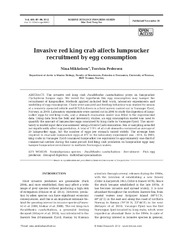| dc.contributor.advisor | Pedersen, Torstein | |
| dc.contributor.author | Mikkelsen, Nina | |
| dc.date.accessioned | 2013-09-25T13:25:49Z | |
| dc.date.available | 2013-09-25T13:25:49Z | |
| dc.date.issued | 2013-10-09 | |
| dc.description.abstract | Mortality of demersal fish eggs caused by predation was investigated in this research project. The selected prey species were the Barents Sea capelin Mallotus villosus and lumpsucker Cyclopterus lumpus L, while the selected predators were capelin itself by cannibalistic behaviour and the invasive red king crab Paralithodes camtschaticus. Both capelin and lumpsucker are commercially important species in the Norwegian fisheries, but capelin is also a very important forage fish for other species.
The egg guarding lumpsucker male was not able to protect his eggs from the egg feeding red king crab. Approximately 8% of the analysed red king crab stomachs contained lumpsucker eggs in 2003. In 2005 and 2006, capelin eggs occurred in 10% and 23% of the analysed red king crab stomachs and capelin in 82% and 22% respectively. As post-spawn capelin occurred more frequently in crab stomachs than capelin eggs, they might have served as alternative prey to capelin eggs.
Average stomach evacuation time for lumpsucker in red king crabs was higher than for capelin eggs. Consumption estimates of capelin eggs in red king crab accounted for 0.04% and 2.23% of the eggs available in the years of study, while the minimum estimated mortality due to egg cannibalism in capelin accounted for 1-2% of the total egg production in 2003. The uncertainty in stomach data generated most of the uncertainty in the Monte Carlo estimated consumption of fish eggs by the red king crab.
This study has established new knowledge about fish egg predation by the invasive red king and egg cannibalism in capelin. Mortality in capelin eggs caused by cannibalism and egg consumption by the red king crab may influence mortality of eggs, but is not considered to hamper capelin recruitment. Recruitment of lumpsucker on the other hand, may be hampered by the red king crab that chase away the egg guarding male, damage and feed on his eggs. | en |
| dc.description.doctoraltype | ph.d. | en |
| dc.description.popularabstract | Dødelighet hos lodde- og rognkjeksegg som følge eggpredasjon fra den introduserte kongekrabben på Finnmarkskysten og eggkannibalisme hos lodde ble studert. Både lodde og rognkjeks er kommersielle arter og lodde har en spesielt viktig rolle som byttedyr for mange andre arter (torsk, sild, sjøpattedyr og sjøfugl) i Barentshavet. Undervannsvideo viste at rognkallen ikke var i stand til å beskytte sine egg mot kongekrabben. Kongekrabber ble fanget ved dykking og mageinnholdet ble analysert og ca. 8 % av krabbene hadde beitet på rognkjeksegg. Mageanalysene viste at utgytt lodde er mer attraktivt som bytte for kongekrabben enn loddeegg, men enkelte krabber spesialiserte seg på beiting av fiskeegg.
Fordøyelseshastigheten av lodde- og rognkjeksegg hos kongekrabbe ble målt i eksperiment, og de små loddeeggene ble fordøyd hurtigere enn de større rognkjekseggene. Kongekrabben i Varangerfjorden spiste så mye rognkjeksegg at den kan redusere rekrutteringen hos rognkjeks i Varangerfjorden betydelig. Beitingen på loddeegg fra kongekrabbe og ved eggkannibalisme var for liten til å redusere lodderekrutteringen merkbart. | en |
| dc.description.sponsorship | University of Tromsø | en |
| dc.description | Papers 1 and 3 of this thesis are not available in Munin: <br/>1. A. Slotte, N. Mikkelsen and H. Gjøsæter: 'Egg cannibalism in Barents Sea capelin in relation to a narrow spawning distribution', Journal of Fish Biology (2006), vol. 69(1):187–202, available at <a href=http://dx.doi.org/10.1111/j.1095-8649.2006.01085.x>http://dx.doi.org/10.1111/j.1095-8649.2006.01085.x</a> <br/>3. Nina Mikkelsen and Torstein Pedersen: 'Invasive red king crabs feed on both capelin and their eggs' (manuscript) | en |
| dc.identifier.isbn | 978-82-8266-066-2 | |
| dc.identifier.uri | https://hdl.handle.net/10037/5428 | |
| dc.identifier.urn | URN:NBN:no-uit_munin_5130 | |
| dc.language.iso | eng | en |
| dc.publisher | University of Tromsø | en |
| dc.publisher | Universitetet i Tromsø | en |
| dc.rights.accessRights | openAccess | |
| dc.rights.holder | Copyright 2013 The Author(s) | |
| dc.rights.uri | https://creativecommons.org/licenses/by-nc-sa/3.0 | en_US |
| dc.rights | Attribution-NonCommercial-ShareAlike 3.0 Unported (CC BY-NC-SA 3.0) | en_US |
| dc.subject | Capelin | en |
| dc.subject | Lumpsucker | en |
| dc.subject | Red king crab | en |
| dc.subject | Invasive species | en |
| dc.subject | consumption | en |
| dc.subject | Egg predation | en |
| dc.subject | Stomach evacuation | en |
| dc.subject | Cannibalism | en |
| dc.subject | Recruitment | en |
| dc.title | Predation on the demersal fish eggs of capelin Mallotus villosus and lumpsucker Cyclopterus lumpus in relation to recruitment | en |
| dc.type | Doctoral thesis | en |
| dc.type | Doktorgradsavhandling | en |


 English
English norsk
norsk

